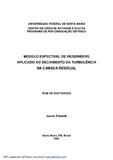| dc.creator | Palandi, Joecir | |
| dc.date.accessioned | 2017-05-08 | |
| dc.date.available | 2017-05-08 | |
| dc.date.issued | 2005-10-22 | |
| dc.identifier.citation | PALANDI, Joecir. Spectral model de heisenberg applied to the decline of the turbulence in residual layer. 2005. 80 f. Tese (Doutorado em Física) - Universidade Federal de Santa Maria, Santa Maria, 2005. | por |
| dc.identifier.uri | http://repositorio.ufsm.br/handle/1/3882 | |
| dc.description.abstract | In the study of the dispersion of contaminants in the atmosphere by computational simulations, the Eulerian approach, based in the diffusionadvection equation, is largely employed. In these simulations, concentration values are calculated at each point of a fixed grid in space and time and for this to be done it is necessary to determine an appropriated eddy diffusivity to the planetary boundary layer under consideration. The aim of this work is to describe the decay of turbulence in the residual layer and to derive the
corresponding eddy diffusivity for the case of a homogeneous (in the horizontal plane) and isotropic turbulent flow neglecting mechanical and thermal production effects. The decay of turbulence is described as a process in which
eddies of a certain size loss their energy by the effect of an eddy viscosity associated with the smallest eddies through a cascade of interactions of local character in the sense of Heisenberg s model. The eddy diffusivities are calculated by considering the dispersive effects of the energy-containing eddies on the basis of Taylor s statistical diffusion model. Considering the hypothesis that the law of decay of the energy spectral density function associated with the
ith axis of the reference system is similar to the law of decay of the tridimensional energy spectral density function, the corresponding variance of the turbulent part of the velocity and the corresponding eddy diffusivity are calculated. These quantities, in particular for the vertical axis, are compared
with results of large eddy simulations (LES) showing very good agreement. Finally, incorporating the calculated eddy diffusivity in a Eulerian model, the effect of turbulence in the vertical dispersion of an passive scalar contaminant in
the residual layer is described for the special case of a instantaneous bidimensional emission source (area source) at a certain height over land and zero mean wind velocity. | eng |
| dc.format | application/pdf | por |
| dc.language | por | por |
| dc.publisher | Universidade Federal de Santa Maria | por |
| dc.rights | Acesso Aberto | por |
| dc.subject | Física | por |
| dc.subject | Turbulência | por |
| dc.subject | Difusão atmosférica | por |
| dc.subject | Atmosfera | por |
| dc.subject | Physics | eng |
| dc.subject | Turbulence | eng |
| dc.subject | Atmospheric diffusion | eng |
| dc.subject | Atmosphere | eng |
| dc.title | Modelo espectral de heisenberg aplicado ao decaímento da turbulência na camada residual | por |
| dc.title.alternative | Spectral model de heisenberg applied to the decline of the turbulence in residual layer | eng |
| dc.type | Tese | por |
| dc.description.resumo | No estudo da difusão de um contaminante na atmosfera por meio de simulações computacionais é bastante utilizada a perspectiva euleriana, baseada na equação da difusão-advecção. Nessas simulações, os valores de concentração são calculados em cada ponto de um retículo fixo no espaço e no tempo e para que isso possa ser feito, é necessário determinar a difusividade turbulenta (coeficiente de difusão turbulento) para o tipo de camada limite planetária em questão. O objetivo desse trabalho é descrever o decaimento da turbulência na camada residual e derivar a correspondente difusividade turbulenta no caso de um escoamento turbulento homogêneo (no plano horizontal) e isotrópico, desprezando os efeitos mecânicos de cisalhamento e térmicos das correntes de convecção. O decaimento da turbulência é descrito
como um processo em que os turbilhões de certo tamanho perdem energia por efeito de uma viscosidade cinemática turbulenta associada aos turbilhões menores através de interações em cascata de caráter local nos moldes do
modelo de Heisenberg. A difusividade turbulenta é calculada pelos efeitos dispersivos dos turbilhões energéticos com base no modelo estatístico de Taylor. Com a hipótese de que o decaimento da função densidade espectral de energia unidimensional associada ao i-ésimo eixo do sistema de referência é similar à lei de decaimento da função densidade espectral tridimensional, calcula-se a correspondente variância da componente turbulenta da velocidade e a correspondente difusividade turbulenta e essas grandezas associadas ao eixo vertical, em particular, são comparadas com resultados obtidos por simulação numérica de grandes turbilhões (LES) mostrando uma concordância muito boa. Finalmente, incorporando a difusividade turbulenta calculada num modelo euleriano, descreve-se o efeito da turbulência na dispersão vertical de um contaminante escalar passivo na camada residual no caso especial de uma fonte bidimensional (fonte área) com emissão instantânea situada a uma certa altura acima do solo e na ausência de vento. | por |
| dc.contributor.advisor1 | Degrazia, Gervásio Annes | |
| dc.contributor.advisor1Lattes | http://buscatextual.cnpq.br/buscatextual/visualizacv.do?id=K4787248Z6 | por |
| dc.contributor.referee1 | Vilhena, Marco Túllio Menna Barreto de | |
| dc.contributor.referee1Lattes | http://lattes.cnpq.br/9362686215096702 | por |
| dc.contributor.referee2 | Goulart, Antonio Gledson de Oliveira | |
| dc.contributor.referee2Lattes | http://buscatextual.cnpq.br/buscatextual/visualizacv.do?id=K4791371J5 | por |
| dc.contributor.referee3 | Dourado, Marcelo Sandin | |
| dc.contributor.referee3Lattes | http://buscatextual.cnpq.br/buscatextual/visualizacv.do?id=K4784065H3 | por |
| dc.contributor.referee4 | Acevedo, Otávio Costa | |
| dc.contributor.referee4Lattes | http://buscatextual.cnpq.br/buscatextual/visualizacv.do?id=K4796988J8 | por |
| dc.publisher.country | BR | por |
| dc.publisher.department | Física | por |
| dc.publisher.initials | UFSM | por |
| dc.publisher.program | Programa de Pós-Graduação em Física | por |
| dc.subject.cnpq | CNPQ::CIENCIAS EXATAS E DA TERRA::FISICA | por |


